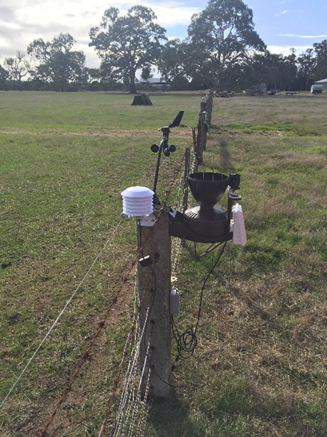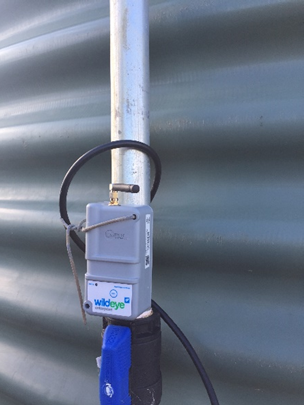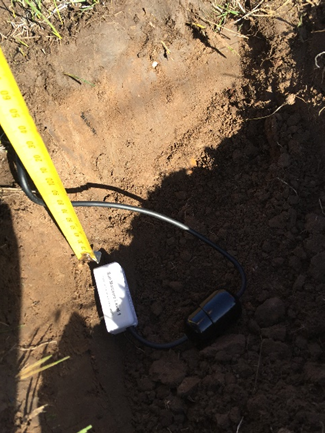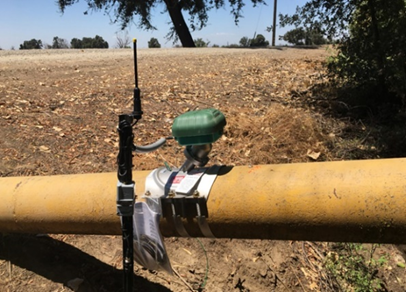AgTech for earlier decisions
Download a printable version of this page: AgTech Bytes – ![]() [PDF File - 1.5 MB]
[PDF File - 1.5 MB]
Johnny Gardner operates ‘South Mokanger’, near Cavendish, in Western Victoria, running about 11,000 Composite sheep and trading 400-500 cattle over 1,700 hectares. Johnny took part in the Smart Farm Sensor Demonstration with the local Grassland Society of Southern Australia (GSSA) group. The aim was to test commercially available AgTech devices and learn about application on farms in South West Victoria.

Johnny believes he is at the start of his learning journey with AgTech. He is testing both the application and ease of use of AgTech devices in his operation and the application of the data they generate.
After participating in the AgTech trial Johnny felt it was difficult to quantify the initial benefits of the sensors he was testing. However, he believed that over time there will be clear advantages from the data generated by the devices to help make more informed decisions on farm. For example, Johnny explained “the BOM says my average (rainfall) is 687mm, but ask me in a year or two when I have some real data.”
The projected benefit on Johnny’s property was calculated using the weather and soil moisture data to make decisions earlier. Johnny has the potential to better forecast pasture production – to estimate impact on cattle and sheep trade decisions and to move stock to containment areas.
Johnny felt the data provided by the weather station and soil moisture probe could be used to move stock into containment two weeks earlier than a pasture visual assessment. The additional margin for grown out animals could result in an extra $14 per hectare in year one or $10 extra per head. This value considers additional grain costs, the full purchase price of the weather station and soil moisture probe, subscription costs and a benefit of $2,567 every year after.
If pastures were rested at peak times of moisture stress and then able to return into the rotation more quickly, it could generate a further potential benefit of $5,230, calculated using the cost of using grain instead of pasture over a six-week period. This is a saving based on not having to renovate pastures due to overgrazing reproductive tillers.
Choice of devices and provider
As part of the demonstration, Johnny trialled Wildeye as his AgTech provider (Table 1). Johnny said that he “was impressed with Wildeye’s willingness to come and resolve any issues”. This helps builds the trust Johnny suggests is required to install, use, operate and rely on the data for farm decision making. Johnny was also trialling 3G as a connection solution – the mobile phone network.
Table 1: Summary of Devices.
Device/sensor(s) installed | 1 Weather station, 1 Soil Moisture Probe, 1 Tank# and 1 Water flow# |
Device Connectivity solution | 3G |
Device management software/Dashboard | Wildeye |
Dashboard platform | Web accessible from computer or mobile device |
Using the equipment
The use of sensors on farm to complement or replace physical observations is a novel concept to most farmers, including Johnny. However, it takes a great deal of trust to rely on the data to make accurate judgements that are equal to or better than the human eye.
Johnny uses AgriWebb, a livestock and farm management software program. The data from his devices is automatically sorted and retrieved from the Cloud environment into his farm management software.
Johnny has not experienced any issues with his 3G connectivity solution, given that his farm is relatively flat and in reasonable proximity to a large regional centre repeater tower.
Weather station
The weather station measures rainfall, relative humidity, wind speed and direction, Delta T, solar radiation, wind chill, fire danger index and evapotranspiration. It was ideal for Johnny’s needs as he could view the data on his mobile phone for a 6km area of his farm.
Johnny accesses the rainfall data from Wildeye and inputs it into AgriWebb farm management software, where he also stores pasture dry matter assessments. He is hoping to develop his knowledge of productivity benchmarks through correlating this data over time. Johnny is also hoping to use the windchill index (temperature and wind) data collected over time to analyse and compare his lambing paddocks. This data could provide insights to make tactical decisions for provision of shelter and perhaps even longer-term decision about altering the timing of lambing.
Johnny believes that the data he can obtain from the weather station will make it the most valuable of all the devices installed on farm.

Tank sensor
The tank sensor has a pressure probe at the base of the tank which enables the water level to be displayed on the dashboard.
The tank monitor was installed to provide surety of water availability in summer to stock. In the two years since the device was installed, there has been only one problem with the tank, which triggered an SMS message. The value for Johnny has largely been peace-of-mind, with the knowledge that he would be notified of an issue and could address it before there are serious implications.

Soil moisture sensor
A soil moisture senor or probe, as they are often referred to, has the capability of detecting soil moisture at different depths along its length.
The 80cm soil probe was installed out of curiosity but has been found to provide useful data on subsoil moisture. This device has the potential to improve the decision making, providing data to trigger placing sheep in containment areas and start supplementary feeding on Johnny’s property. This may also have an impact on the pasture renovation schedule due to better pasture management.
Johnny believes the biggest payback will be throughout summer. “This is about using the soil moisture data – if we don’t have rain in the next week then pasture growth will drop, and I need to make a decision to either feed or sell stock.” Johnny felt the soil moisture probe was a beneficial tool for helping him develop and understand triggers for pasture growth rates, suggesting visual observations are around two weeks delayed from soil moisture probe measurements.

Water flow sensor
Water flow sensors are typically installed to detect the flow of water in irrigation systems. However, these are equally useful for other purposes as they determine the amount of water that passes through them. They can be used to determine if troughs have leaks, are overflowing or if stock have increased or decreased their water demands.
Johnny’s experience with the water flow meter has been mixed, adding he “might have been unlucky too” as sediment in the pipeline clogged up the sensor which meant it wasn’t working correctly upon installation. This was rectified with assistance from Wildeye. Given Johnny’s experience, he may explore using tank sensors to monitor his water supply.

Commercial cost for devices
The total commercial cost for the purchase and use of the four AgTech sensors for one year - was $7,507. This includes the device subscription on the dashboard at approximately $27.27 per device per month. Email alerts are free.
The approximate costs and benefits to the Gardner farm are outlined below. Devices used in combination don’t always have a cumulative benefit, but may, in conjunction with the use of a second device, provide a whole farm solution and yield a net benefit.
Table 2: Device costs and benefits
| Costs | Potential Benefits | ||
Device | Up-front cost | Ongoing annual cost of device software / subscription | Potential financial benefits | Other benefits |
Weather Station | $3000 | $27.27/ mth or $327 annually | Automated records Better and Safer Spraying | Validate decisions by providing: Temperature Monitoring with Alerts Evapotranspiration (ET) Delta-T & Growing Degree Days Chill Portions and Chill Hours Humidity and Leaf Wetness Fire Danger Index |
Soil Moisture | $1400 | NIL Included with weather station But if installed separately would be $27.27/month | Early identification of plant stress or slower growth periods allowing earlier stock containment or feeding decisions
Combined weather station & soil probe benefit: $2,567[i] Potential for a further $5,230[ii] | Assitance with timing of sowing and fertilizer applications |
Tank Depth sensor | $1150 | $240 /year | Pump and water costs over a 24-hour period x 5 faults per year $2,996[iii] | Peace-of-mind. Positive impact on stock welfare during warmer months by ensuring adequate stock water availability |
Flow Meter | $1150 | $240 / year | Improved understanding of water use and requirements per day, per month and per year | Peace of mind. Compare with ET Remote management |
Total AgTech solution | $6,700 | $807 | $10,793 Net benefit |
$3,286 |
Conclusion
The net benefit from all the sensors and AgTech installed on the Gardner farm was estimated at $3,286 calculated by valuing the use of the data generated from all four devices, less the cost of installation and dashboard subscription in year one. The use cases considered were improved feeding decisions due to available weather station and soil moisture data, helping prioritise containment, selling and feeding of livestock. To test this potential benefit, the improvements in stock performance, economic return, and pastures need to be measured.
Johnny has the confidence and drive to trial other devices in the future such as an electric fence monitor, another tank monitor and invest in solar.
Johnny’s recommendations for those considering investing in AgTech were similar to other users in the Smart Farm Sensor Trial. They include:
- Find a supplier that provides support for devices as well as the software. Johnny was happy with his choice of Wildeye for the range of devices and support he received.
- Carefully plan where best to locate and position devices to capture the best quality data relevant to your farm
- On-farm demonstrations https://agriculture.vic.gov.au/on-farm-demos
- Link to further AgTech Bytes.
Where do I find out more?
About the project
Smart Farm Sensor Demonstrations: This project is supported by Glenelg Hopkins CMA, through funding from the Australian Government’s National Landcare Program, Agriculture Victoria, Grasslands Society of Southern Australia, Southern Farming Systems and Southern Grampians Shire Council. The project ran from 2019-21 and tested and demonstrated a range of devices on farms in the southwest region, including stock water and tank monitors, soil moisture probes, electric fence sensors and weather stations. The sensors provided real-time feedback to producers enabling them to make more informed decisions and better use of labour, time, and capital.